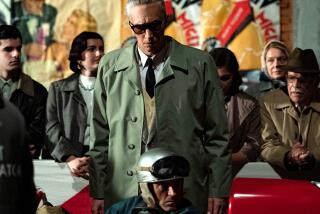A Slinky Speedster
- Share via
PHOENIX — Our Ferrari 348 Spider, dressed for summer in crocus yellow and black leather, spent its down time between desert runs parked outside the grandam Arizona Biltmore.
Measured by endless and coveting glances--also by a steady dribble of snapshooters using the Spider as their vacation prop--Pininfarina, who styled the 1993 car, clearly outscored Frank Lloyd Wright, who designed the 1936 hotel.
Such public appreciation also proves that despite a noticeable softening of sales and the sagging images of super-cars, Ferrari survives as a 47-year sculptor of genuine performance art and the mystical marque--with a new convertible that is no usurper.
The 348 Spider has the full song of Ferrari, an aluminum V-8 alto ascending into a ripping, purring Italian opera that on still mornings will cock ears in the next county.
Without the tin top of the 348 coupe, the Spider shows the slinkier look of a tough, purposeful, road-racing classic. It is enhanced by broad Bridgestones on 17-inch wheels and vaned side ducts a la Testa Rossa that actually deflect cooling air into radiators.
Like every Ferrari since the 1947 125 C Sport, the Spider stands waist high. There’s also a mild bustle--amply louvered--that is typical of mid-engine cars and a road-sweeper front low enough to mush snails into escargot .
And its air horn puts out a cheekier sound than Pete Sampras cussing Wimbledon.
The Spider has been refined mechanically and is fractionally quicker from rest and faster at the top end than its hard-top sibling. A smaller muffler reduces exhaust resistance, more efficient electronics allow better engine management and the combination squeezes an additional 12 horsepower--to 312--from last year’s 3.4-liter engine.
Ferrari’s first soft top since the four-place Mondial of the ‘80s--also the first two-seat Spider, or Spyder, since the ’74 365 Daytona--the 348 has gone topless with complete dignity.
It looks and rides as a thoughtfully conceived, thoroughly engineered convertible and not some decapitated coupe.
Top down, the windshield belongs to the flow of the overall design and does not stick out like a sore dorsal fin. Top up, lines of the canvas roof are clean and integral, and construction substantial without any appearance of temporary shelter.
Fit of the top is impeccable with God’s breezes staying out and man-made refrigerated air staying in even when heading past Palm Springs one 105-degree noon in June.
Although a manual operation--Ferrari considers power seats and automatic transmission as equipment for softies--raising and lowering the roof is a one-catch, one-lever, one-person, one-minute operation. In fact, setting the leather boot over the top takes longer than stowing the roof, owing to Murphy’s Law of convertibles: One snap must always refuse to fasten.
Reinforcement--mainly a stiffer windshield frame with some chassis strengthening--has been conservative. Still, there is zero cowl, windshield or hood flex no matter the speed or road surface.
Aerodynamically, the car is an anomaly. Wind noise with the top down is greater at moderate speeds than when tempting fate and the CHP. There’s also less cockpit turbulence and fewer ruffled hairdos with the windows down than raised. Those funny Italians.
*
The interior is businesslike because the business of anyone driving a Ferrari is staying alert amid blurred scenery, not leaning back and admiring the view.
Primary instruments are saucers set dead ahead for glimpsing all you need to know at high speed. Secondary dials are mounted in the center console because knowing how much gas remains is hardly a concern at 150 m.p.h.
Seats are for supporting butts, lumbars and thighs, not coddling them until sensory functions are lost. Pedal positions are a world standard for heel-and-toe shifters who would rather lose their credit line than botch a gear change.
The only cockpit insignia is Ferrari’s celebrated prancing horse as the horn button. The gearshift is a licorice golf ball atop a chrome stalk. A brushed aluminum gate guides the shift pattern with reverse top left and first-to-second a careful shove-and-shuffle across the bridge and up.
If all that sounds backward, even awkward, see it as Ferrari’s dedication to the basics of precision driving, a Nuvolari formula followed since the ‘40s--and one that lesser exotic car makers only began replicating in the ‘60s.
And the 348 Spider fully subscribes to this Gospel According to Enzo Ferrari: That mechanical purity mated to a driver’s senses and reflexes is technology enough.
Balancing a car by throttle and brakes; shifting deftly to preserve power; feeling steering lighten as speed increases and manual demands must adjust instinctively. These remain responsibilities of a driver, goes the creed, not some luxury car’s automatic controls.
Similarly, a Ferrari demands the soul of a duelist willing to go one-on-one with uncaring machines. That’s why the car is so misunderstood.
It isn’t transportation. It is a third car for enthusiasts who drive some far dimension where motoring is still a skill and a joust against their individual limits. The reward is an exhilaration that remains to dying days.
In contrast to all this macho poetry, the Spider is remarkably civilized. The gears are a little stiff, the clutch certainly wasn’t built by Honda and steering is a definite wrestle at parking lot speeds.
But this is an apprenticeship. Handling stiffness of the 348 is no worse than wrangling a Corvette. Accept it as the positive heft of heavy-duty mechanicals built to perform as few cars can, at speeds even fewer can attain.
In that environment, the Spider becomes a spell.
Gears are remarkably long with zero to 120 m.p.h. the range of the first four. Mid-range acceleration is so brisk it takes only nine seconds to sprint from freeway speeds to 100 m.p.h. And within this envelope, the Ferrari lives and breathes.
Now steering is light and the car turns exactly where hands dictate, not an inch more or less. Better yet, during fast cornering, the Spider seems pinned by down forces. No matter the urging of weight and lateral motion it rarely shows a lighter side. Under full throttle, the car exits corners as if drop-kicked.
Huge anti-lock brakes--11.8-inch discs up front, 12-inch discs out back--take the panic from fast stops. Forward vision is superb, allowing the car to be positioned with Formula racer precision.
Yet driving a Ferrari is much more than pandemonium.
It may very well be at its best on a high-speed cruise across a desert interstate. It is ready and anxious to explode with one downshift, one drop of a foot. But held to a growl, still on a leash, the Spider becomes an exquisite menace, the driver its keeper.
*
Still, a car that costs $121,900--not including gas guzzler and luxury taxes--and doesn’t come with a radio may be carrying purity and the Ferrari ideology too far.
A spare tire would be nice. In these litigious days, air bags might be worth ruining the cut of Ferrari’s perfect steering wheel.
Not bothering with such apparent trivialities has long been the stubbornness of Ferrari. Some North American buyers saw the deficiencies as an arrogant swipe at a country that cared. It certainly was a country that purchased more Ferraris than any other.
But that was yesterday. Founder Ferrari is dead and long live the godfather. Younger, broader executives are in place and reaching to touch the Ferrari following. “Ferrari is reforming itself in America and getting closer to their customers,” says a spokesman.
As part of that re-Americanization, Ferrari could well install a product nit picker--as does Rolls-Royce and Mercedes--to make sure nickel-and-dime oversights do not continue flawing a six-figure icon.
Start with a three-figure sound system. Then a redesign of the Spider’s sexist doors and flush button latches that simply cannot be opened by a woman with nails. It wouldn’t take an engineering genius to balance those doors better and to remake interior handles that seem to have been lifted from a Coleman cooler.
And with air bags on both sides, Ferrari could dump the dreadful mechanical belts it is forced to use in lieu.
Ferrari hopes the 348 Spider will be the catalyst of its friendlier image, a less intimidating product and U.S. sales superior to 500 units sold last year.
For what it is worth to that vision: Wayne Gretzky recently took delivery of his Spider from Ferrari of Beverly Hills.
For what that might mean to hockey fans: He did not apply for Ontario plates.
1993 Ferrari 348 Spider
Cost
* Base, $121,900
* As tested, $133,900. Includes luxury and gas guzzler taxes, anti-lock brakes, leather interior, air conditioning, power windows and mirrors.
Engine
* 3.4 liter, 32-valve V-8 developing 312 horsepower.
Type
* Mid-engine, rear-drive, two-seat sports car.
Performance
* 0-60 m.p.h., as tested, 5.8 seconds.
* Top speed, estimated, 167 m.p.h.
* Fuel consumption, EPA city and highway, 13 and 19 m.p.g.
Curb Weight
* 3,250 pounds.
The Good
* Purest of sports car classics.
* Stable, civilized at any speed.
* Magnificent looks.
* Maestro performance.
The Bad
* Pep Boys seat belts, female-unfriendly door latches and other small irritants.
* 20th-Century motoring demands air bags and sound systems.
The Ugly
* You’ve got to be kidding.






